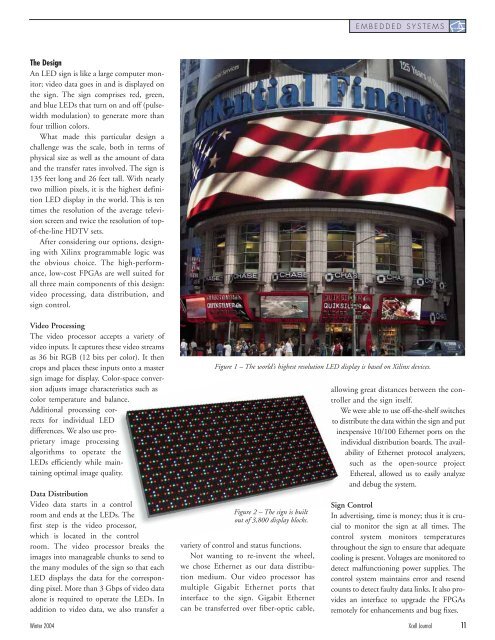Xcell Journal: The authoritative journal for programmable ... - Xilinx
Xcell Journal: The authoritative journal for programmable ... - Xilinx
Xcell Journal: The authoritative journal for programmable ... - Xilinx
You also want an ePaper? Increase the reach of your titles
YUMPU automatically turns print PDFs into web optimized ePapers that Google loves.
<strong>The</strong> Design<br />
An LED sign is like a large computer monitor;<br />
video data goes in and is displayed on<br />
the sign. <strong>The</strong> sign comprises red, green,<br />
and blue LEDs that turn on and off (pulsewidth<br />
modulation) to generate more than<br />
four trillion colors.<br />
What made this particular design a<br />
challenge was the scale, both in terms of<br />
physical size as well as the amount of data<br />
and the transfer rates involved. <strong>The</strong> sign is<br />
135 feet long and 26 feet tall. With nearly<br />
two million pixels, it is the highest definition<br />
LED display in the world. This is ten<br />
times the resolution of the average television<br />
screen and twice the resolution of topof-the-line<br />
HDTV sets.<br />
After considering our options, designing<br />
with <strong>Xilinx</strong> <strong>programmable</strong> logic was<br />
the obvious choice. <strong>The</strong> high-per<strong>for</strong>mance,<br />
low-cost FPGAs are well suited <strong>for</strong><br />
all three main components of this design:<br />
video processing, data distribution, and<br />
sign control.<br />
Video Processing<br />
<strong>The</strong> video processor accepts a variety of<br />
video inputs. It captures these video streams<br />
as 36 bit RGB (12 bits per color). It then<br />
crops and places these inputs onto a master<br />
sign image <strong>for</strong> display. Color-space conversion<br />
adjusts image characteristics such as<br />
color temperature and balance.<br />
Additional processing corrects<br />
<strong>for</strong> individual LED<br />
differences. We also use proprietary<br />
image processing<br />
algorithms to operate the<br />
LEDs efficiently while maintaining<br />
optimal image quality.<br />
Data Distribution<br />
Video data starts in a control<br />
room and ends at the LEDs. <strong>The</strong><br />
first step is the video processor,<br />
which is located in the control<br />
room. <strong>The</strong> video processor breaks the<br />
images into manageable chunks to send to<br />
the many modules of the sign so that each<br />
LED displays the data <strong>for</strong> the corresponding<br />
pixel. More than 3 Gbps of video data<br />
alone is required to operate the LEDs. In<br />
addition to video data, we also transfer a<br />
Figure 1 – <strong>The</strong> world’s highest resolution LED display is based on <strong>Xilinx</strong> devices.<br />
Figure 2 – <strong>The</strong> sign is built<br />
out of 3,800 display blocks.<br />
variety of control and status functions.<br />
Not wanting to re-invent the wheel,<br />
we chose Ethernet as our data distribution<br />
medium. Our video processor has<br />
multiple Gigabit Ethernet ports that<br />
interface to the sign. Gigabit Ethernet<br />
can be transferred over fiber-optic cable,<br />
EMBEDDED SYSTEMS<br />
allowing great distances between the controller<br />
and the sign itself.<br />
We were able to use off-the-shelf switches<br />
to distribute the data within the sign and put<br />
inexpensive 10/100 Ethernet ports on the<br />
individual distribution boards. <strong>The</strong> availability<br />
of Ethernet protocol analyzers,<br />
such as the open-source project<br />
Ethereal, allowed us to easily analyze<br />
and debug the system.<br />
Sign Control<br />
In advertising, time is money; thus it is crucial<br />
to monitor the sign at all times. <strong>The</strong><br />
control system monitors temperatures<br />
throughout the sign to ensure that adequate<br />
cooling is present. Voltages are monitored to<br />
detect malfunctioning power supplies. <strong>The</strong><br />
control system maintains error and resend<br />
counts to detect faulty data links. It also provides<br />
an interface to upgrade the FPGAs<br />
remotely <strong>for</strong> enhancements and bug fixes.<br />
Winter 2004 <strong>Xcell</strong> <strong>Journal</strong> 11

















